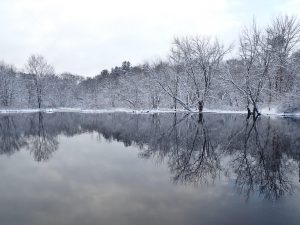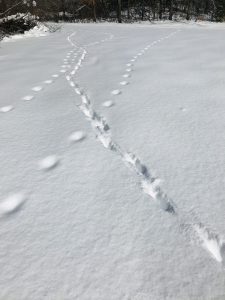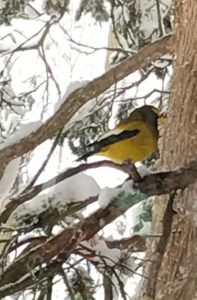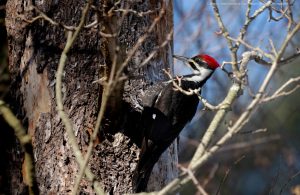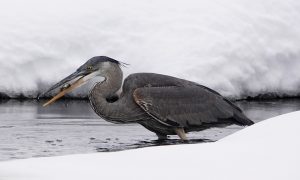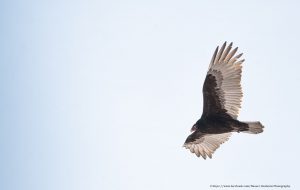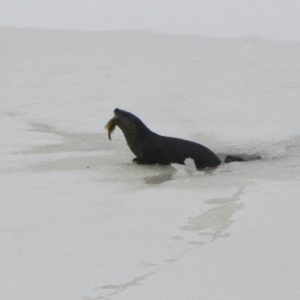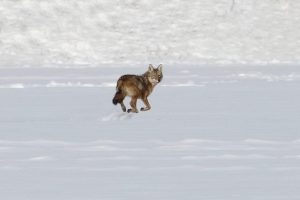Written by Gwyn Loud for the Lincoln Land Conservation Trust. She welcomes your sightings and questions at 781-259-8690 or gwynloud555@gmail.com.
SNOW describes February, with the first major storm of the month on February 1-2 giving us 16-20 inches. Several subsequent smaller storms have added inches of powder and more snow is in the forecast. Plows are busy, children and skiers happy. What is the effect on wildlife? Small mammals such as voles and shrews benefit, as their tunnels are insulated and make them less exposed to predators. On the other hand, the predators such as owls and hawks have a harder time catching prey, and large mammals have to expend more energy to run, bound, or walk through deep snow and find a meal. Low-growing seed heads, food for many winter birds, are no longer exposed. Wild turkeys for example, “feed in flocks, but if the snow has thawed and hardened into an icy crust, they will have trouble reaching the nuts and seeds underneath. They will turn to evergreen branches or the fertile fronds of sensitive fern that stick up above the snow”, according to Mass. Audubon’s Outdoor Almanac. On the hopeful side, we are now past the midpoint of winter, and signs of spring are noticeable in increased bird song and more hours of daylight. It may be hard to believe, but by the end of the month we can expect to hear red-winged blackbirds calling as they make their way north.
It never fails to impress me that our backyard songbirds can survive bitterly cold days and nights. We see them looking puffed up as they lift their down feathers, the ones closest to the skin, to trap in body heat. Scrunching low so that legs are covered by feathers and tucking heads into feathers helps against the cold. They have other strategies too; some may huddle together to keep warm overnight or find shelter in empty birdhouses, tree cavities, an open shed, or in dense conifers. Songbirds have high body temperatures (104-111℉) and high metabolism, meaning they need to be eating almost constantly during the day, especially in the cold. Luckily, they can go into a state of torpor at night, lowering their temperature until daylight.
The snow at the start of the month brought a few irruptive species to my feeders: a male evening grosbeak, a common redpoll and seven pine siskins. A wintering female Eastern towhee has been in the neighborhood and pileated woodpeckers have been reported from several parts of town.
A hardy great blue heron was spotted catching both fish and bullfrog tadpoles in the stream south of St. Anne’s where there was just enough open water, and a belted kingfisher was seen there as well. Flocks of wild turkeys have been at Drumlin Farm, some showing breeding behavior and a turkey vulture was photographed overhead, an early arrival from points south.
Admiring my four regular bluebirds exploring bird houses and eating mealworms, I related to what Margaret Renkl wrote recently in a beautiful article in The New York Times: “Watching the tumult of their azure wings one morning, I said aloud to the empty house, ‘A happiness of bluebirds.’ …… It seemed so apt, the way all the other songbird collectives are apt: a radiance of cardinals, a quarrel of sparrows, a trembling of finches, a scold of jays, a murder of crows. Why not a happiness of bluebirds, for who could fail to take heart from birds who carry the summer sky so faithfully on their backs in the slender light of winter?”
On Farrar Pond the carcass of a mute swan became the scene of a feeding competition, captured by Ron McAdow on film. First he witnessed two red-tailed hawks battling for the feast and then his motion-triggered camera revealed nighttime visitors to the carcass. Coyotes, a red fox, and raccoons all took turns having a meal. In daylight a pair of otters came up through the ice, holding a fish. On Osborne Pond, across town, an observer watched a muskrat emerge from the ice and swim out to the bank.
Mid-February is when coyotes are breeding and people have reported hearing their barks and howls in various locations. Within earshot of the Food Project fields on Baker Bridge Road, the coyote calls were unusually loud, going all through the night and even continuing at 7:30 AM, in broad daylight. Coyotes tend to be monogamous, faithful to a mate over several seasons. The litter of four to seven pups will be born in early spring, with both parents caring for the young, sometimes with the help of older offspring. This is also the time when raccoons are breeding and Eastern gray squirrels are giving birth.
During winter, insects are mostly invisible to us but remain an important part of wildlife food. They are cold-blooded, in a stage of rest called diapause, and will resume activities and development when weather warms. Some insects overwinter as eggs or cocoons but others such as carpenter ants and bark beetles remain active as adults, making tunnels and carved galleries deep inside branches and trunks. When we see birds investigating beneath bark, they are looking for forms of insects to eat, and woodpeckers can hammer holes to reach deep enough to find adult ants and beetles. A species of insect which you may see on the snow, looking like sprinkled black pepper, is a type of springtail, the snow flea. Look for them on a sunny day around the base of a tree. As Mary Holland writes, “Snow fleas derive their name from their flea-like ability to leap a distance as much as 20 times their body length- a comparable leap for humans would be a third the length of a football field.”
Over the next few weeks watch for signs of maple sugaring beginning, with spiles, buckets, and tubing on sugar maples. The ideal temperatures for the sap to flow are when it is about 40℉ during the day and it falls below freezing at night. Here’s to a sweet harvest!


